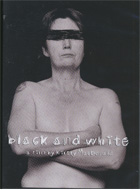
Black and White 2006
Distributed by Women Make Movies, 462 Broadway, New York, NY 10013; 212-925-0606
Produced by Kirsty MacDonald
Directed by Kirsty MacDonald
DVD, color, 17 min.
Adult
Gay and Lesbian Studies, Gender Studies
Date Entered: 08/14/2007
Reviewed by Dan DiLandro, E.H. Butler Library, State University of New York College at BuffaloBlack and White both recounts the history of Mani Bruce Mitchell, born intersexed in 1953 New Zealand, and herm (to use Mitchell’s preferred pronoun) work with author and photographer Rebecca Swan. The first half of the documentary is given to Mitchell’s description of herm birth and upbringing in rural New Zealand as well as herm views on intersexuality and the manner in which people are “socialized” to consider sexuality as a binary, “either/or” concept.
In facing the camera, Mitchell describes how “panic [broke] out” at the hospital upon herm birth; herm mother’s shocked comment “Oh my God, it’s a hermaphrodite” sets the stage for Mitchell’s own incisive and intelligent thoughts on intersexuality. Noting that the first question asked of parents regarding their new offspring often regards the child’s gender—coupled with Mitchell’s own early life on a farm where, s/he admits, one could always tell the sex of an animal—the activist speaks of herm own experiences, as well as theorizing upon the nature of sexuality and gender itself.
At herm first year, Mitchell underwent gender reassignment (without the associated corrective) surgery; and the activist describes how it was herm oversized ears—not the intersexuality—which allowed herm admittance into the Crippled Child Society, which provided herm with free tickets to the circus. Notably, Mitchell was able to see “different” people; and these, one supposes, helped herm to form ideas about the continuum of sexuality and personhood, as opposed to the binary concept with which we are indoctrinated.
At 17 minutes, it is a testament to both Mitchell and director MacDonald that this segment of the film can provide a good deal of information and entertainment. Mitchell describes how herm mother had destroyed all photographs of herm before herm surgery, and she describes one “aggressively” feminized imaged—pink dress, conventionally girlish hairdo—of herm as a child, a photo that was widely disseminated to herm extended family, ostensibly as “proof” that s/he was a happy, healthy little girl. Another photographic image of the young Mitchell is filmically manipulated by the director to inhabit other scenes, underscoring Mitchell’s own spoken concepts of gender identity. Indeed, Mitchell expounds on the destruction of those earliest photos, theorizing that images represent something of an iconography, and that there can be “no change without some image.” Herm words ring surprisingly fresh—especially in the short time allotted to them.
This discussion of image—photographic, personal, and public—though, leads to the film’s second half, which recounts the creative collaboration between Mitchell and author and photographer Rebecca Swan. Swan, the author of Assume Nothing, a book of photography regarding “alliterative” gender identity, is shown working with Mitchell on her new work, ONE. While ONE’s focus is said to be about “who we are as humanity,” the emphasis away from Mitchell works very much to the detriment of film’s message. In fact, the second half of the film shows some collaboration between the two, but Mitchell’s evocative voice is muted.
There is some discussion of using certain photos for the new text and scenes of images projected onto a public display. (Note that these images often contain nudity, and are thus perhaps inappropriate for certain audiences.) Sadly, this section of the film feels much more like a marketing campaign for Swan’s book, and has none of the reflective and intellectual sense of the first half of the film.
Mitchell notes, importantly, that we, as people, are hovering in a space between “explor[ing] new realities...or a very black and white, conformist, New Reich type of thing.” Mitchell makes an important and essential point, but this is completely overshadowed by the sales campaign that embodies the sense of the film’s second half.
While Mitchell’s views and theorizing present a truly interesting, evocative, and empirical view on society’s learned binary view and how we might reconsider it, the films conclusion presents a dilemma. While audiences might view this film and be intrigued to investigate the fluidity of sexuality and gender, the film must overall be recommended with reservations. Mitchell’s expressed experiences and thoughts are fascinating; and herm very much unique voice as an open intersexual must be considered if only for its rarity, but the last eight or ten minutes of this short film are primarily devoted to Swan’s book—not an exploration of the ideas it might contain. Therefore, Black and White is recommended with reservations for libraries or special collections that focus on gay and lesbian as well as gender studies.
Awards: